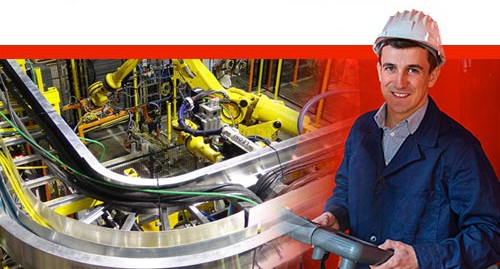For over 50 years, we have dedicated ourselves to providing Industry with best in class wire management solutions and to helping solve mission critical issues.
The needs of today’s schools and universities are changing fast. When it comes to anticipating and meeting those needs, MonoSystems is in a class of its own.
For the past five decades, we’ve made it our business to offer more value to our partners, which in turn provides greater value to their customers.
Innovations in Wire Mesh Cable Trays Shaping the Future of Infrastructure by 2025
In the rapidly evolving landscape of modern infrastructure, the role of wire mesh cable trays has become increasingly vital. As per the latest industry report by Grand View Research, the global market for cable management systems—including wire mesh cable trays—is projected to reach USD 7.9 billion by 2025, showcasing a robust compound annual growth rate (CAGR) of 5.1%. This significant growth is driven by the rising demand for efficient cable management solutions, particularly in commercial and industrial construction projects. Different types of wire mesh cable trays offer unique characteristics tailored to various applications, ranging from lightweight installations in small offices to heavy-duty frameworks in manufacturing facilities. As we explore the innovations shaping this dynamic sector, it is clear that wire mesh cable trays not only enhance safety and organization but also contribute to the sustainability and operational efficiency of infrastructure projects worldwide.

Emerging Technologies Revolutionizing Wire Mesh Cable Tray Design
The landscape of wire mesh cable tray design is undergoing a transformative shift, driven by emerging technologies that promise to redefine infrastructure development by 2025. With the rapid acceleration of smart cities and the Internet of Things (IoT), the demand for more efficient, sustainable, and adaptable cable management systems is paramount. A recent report indicates that the global market for cable trays is expected to grow significantly, with a projected CAGR of over 5% from 2023 to 2030. This growth is fueled by innovations such as advanced materials that enhance durability and flexibility, while new manufacturing processes reduce costs and environmental impact.
Moreover, the integration of smart technology into wire mesh cable trays is another key trend shaping the industry. Through IoT connectivity, these trays can now monitor cable health, detect faults, and provide real-time data analytics, thereby enhancing the reliability of power distribution in critical applications like electrified transportation. Notably, large language models are emerging as powerful tools in the design process, enabling engineers to simulate and optimize cable tray configurations rapidly, which can lead to more efficient designs that cater to the complexities of modern infrastructure. The synergy of these innovations will undoubtedly revolutionize the cable management space, setting a robust foundation for future developments.

Sustainable Materials: A Greener Approach to Cable Tray Manufacturing
As the demand for sustainable infrastructure grows, the cable management industry is undergoing a significant transformation, particularly in the realm of wire mesh cable trays. Cable trays, traditionally made from metals like steel or aluminum, are now being reimagined using eco-friendly materials that reduce environmental impact while maintaining durability and functionality. Innovations in production techniques allow manufacturers to incorporate recycled materials, reducing resource consumption and minimizing waste.
The implementation of sustainable materials in cable tray manufacturing not only addresses ecological concerns but also meets the rising expectations of environmentally-conscious consumers and businesses. Advanced composites and bioplastics are gaining traction as potential alternatives, offering lightweight solutions that do not compromise on strength or performance. As companies strive to align their practices with global sustainability goals, the shift towards greener cable trays exemplifies how infrastructure can evolve responsibly, paving the way for a more sustainable future by 2025.
Smart Integration: Enhancing Infrastructure with Intelligent Cable Management
In an era where technology profoundly influences every aspect of infrastructure, the integration of intelligent cable management systems within wire mesh cable trays is transforming how we approach connectivity. As cities and industries evolve, the demand for more efficient and adaptive cable management solutions is paramount. These innovations not only enhance the organization and safety of electrical installations but also streamline upgrades and maintenance, minimizing downtime.
Smart integration technologies, such as sensors and IoT devices, allow for real-time monitoring of cable systems. This capability enables predictive maintenance, identifying potential issues before they become major problems. Furthermore, such systems can adapt to changing infrastructure needs, allowing for easier reconfiguration of cable pathways without significant disruptions. The prevalence of these intelligent cable management solutions in wire mesh trays signifies a shift towards a more responsive and sustainable approach to infrastructure development, driving industries towards a smarter future by 2025.
Innovations in Wire Mesh Cable Trays Shaping the Future of Infrastructure by 2025
This chart illustrates the projected growth in investment for intelligent cable management over the years leading up to 2025, highlighting the increasing importance of innovations in wire mesh cable trays within infrastructure development.
Case Studies: Successful Implementations of Advanced Cable Tray Systems
The integration of advanced wire mesh cable trays is revolutionizing infrastructure across various sectors.
Case studies highlight notable implementations that showcase the effectiveness of these systems in managing cable organization and improving safety.
For instance, a leading tech firm recently employed a state-of-the-art wire mesh cable tray system in its data center.
The design not only improved airflow but also facilitated easier access for maintenance, significantly reducing downtime.
Another compelling example comes from an industrial manufacturing plant that faced challenges with heat accumulation from bundled cables.
By switching to innovative wire mesh trays, the facility achieved better thermal management, resulting in enhanced equipment performance and longevity.
This transformation underscores how advanced cable tray systems can lead to seamless integration within complex infrastructures, providing both functional and aesthetic benefits.
These cases illustrate the potential of wire mesh cable trays to shape the future landscape of infrastructure by 2025, emphasizing their role in efficiency and sustainability.
Future Trends: What to Expect in Wire Mesh Cable Tray Innovations by 2025
Wire mesh cable trays are undergoing a significant transformation as we approach 2025, driven by advancements in materials and design technologies. A report from Industry Research Projects that the global cable tray market will reach $4.5 billion by 2025, reflecting a robust compound annual growth rate (CAGR) of 6.2% during this period. This growth is largely attributed to the increasing demand for efficient cable management solutions in various sectors, including telecommunications, commercial construction, and industrial applications. As sustainability becomes a priority, innovations in cable trays, such as galvanized steel and aluminum materials, are set to enhance durability and reduce environmental impact.

Tips for choosing the right wire mesh cable trays include considering the load capacity and installation environment. Opt for trays that provide adequate ventilation and avoid overheating, particularly in data centers. Additionally, look for customizable options that allow easy integration with existing infrastructure. Another trend to watch is the integration of smart technology in cable trays, enabling real-time monitoring and maintenance alerts, ensuring system reliability and performance.
As we move towards 2025, businesses will also benefit from advancements in manufacturing techniques, such as automated production processes, which will reduce lead times and costs. This shift towards automation not only impacts the efficiency of cable tray production but also ensures high-quality standards and flexibility in design. Embracing these trends will significantly influence how infrastructure projects are designed and executed in the near future.


